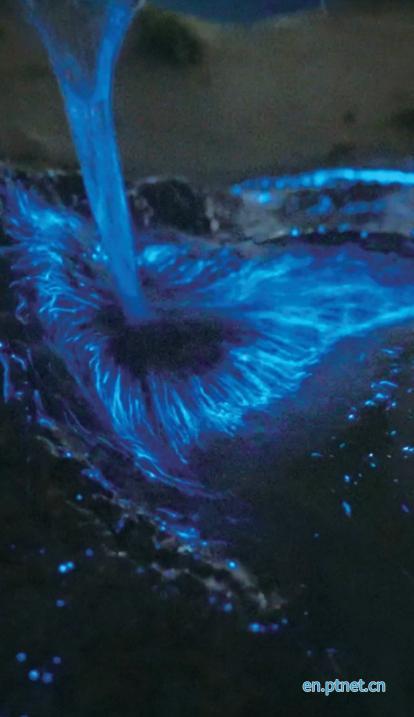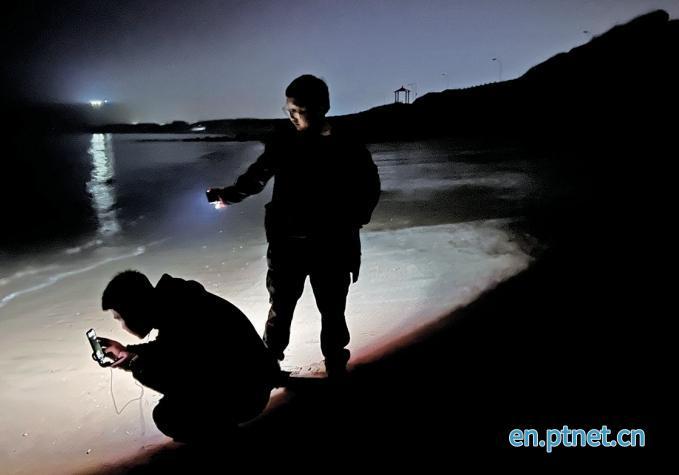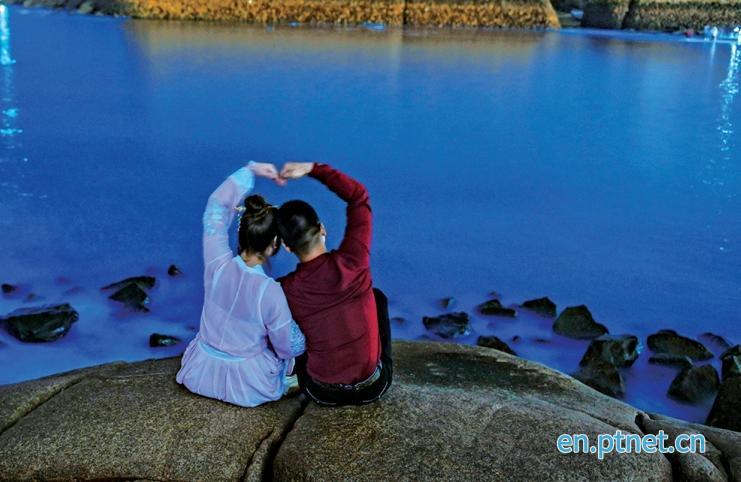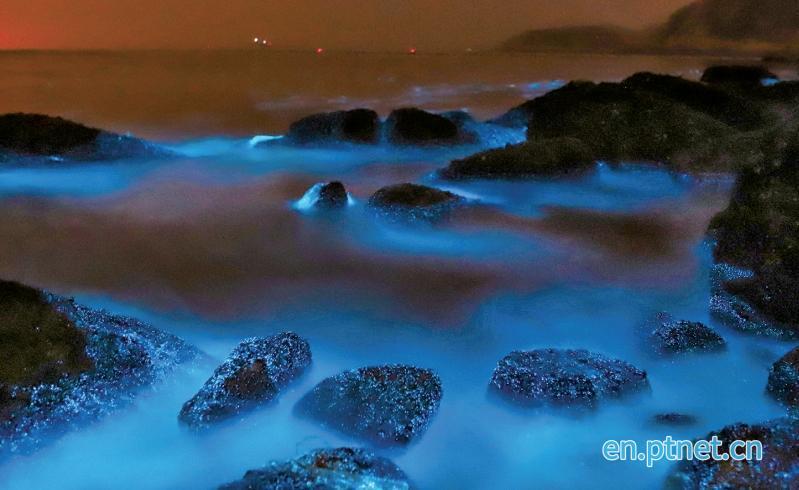Lad from Pingtan devotes eight years to chasing elusive "Blue Tears"
en.ptnet.cn | Updated:2025-03-09 | Lin Kongbo, Stephanie
Liu Xiaobo shares his most memorable photograph of "Blue Tears."
In the dead of night, waves carrying an ethereal blue glow crash onto the shore. For a fleeting moment, the entire beach shimmers like a cascade of falling stars, as if the Milky Way itself has descended to Earth. This breathtaking scene is what 22-year-old Liu Xiaobo has spent the past eight years chasing. Born and raised on Pingtan Island, Liu has dedicated himself to tracking the elusive "Blue Tears"—a natural bioluminescent phenomenon caused by marine plankton.
Armed with data, intuition, and the wisdom of veteran fishermen, Liu has become an expert in predicting when and where these glowing tides will appear. Over the years, he has built a following, earning himself the nickname "The Blue Tear Hunter."
The Spark That Ignited a Passion

"Blue Tears" captured by Liu Xiaobo
Liu's obsession began in 2018 when he stumbled upon a livestream showcasing the mesmerizing glow of "Blue Tears" along the shores of Pingtan. The streamer excitedly announced, "The 'Blue Tears' are erupting at Longwangtou Beach tonight!" Liu, still a novice at the time, grabbed his camera and raced to the spot, only to find nothing but darkness.
Disappointed but undeterred, he followed another livestream hinting at a sighting in Beigang Village. Again, he was met with empty shores. Frustration turned into determination. "I was tired of chasing false leads," Liu recalls. "I decided to figure out the secret behind 'Blue Tears' myself."
Deciphering the Ocean's Secrets
"Blue Tears" are caused by bioluminescent organisms such as Noctiluca scintillans, commonly known as sea sparkles. These microscopic creatures thrive in Pingtan's coastal waters, particularly from April to June when the southern winds prevail.
Determined to predict their arrival with precision, Liu immersed himself in research, poring over tide charts, wind patterns, and temperature shifts. He also turned to his elders. Growing up on Dongxiang Island, where nearly every household has a history of fishing, Liu learned invaluable knowledge from his grandfather and father. "The tide on the third day of the lunar month is different from the one on the eighteenth," his grandfather would say. "New and full moons bring the strongest tides," his father added. Liu meticulously recorded these insights in his notebook.
Through countless nights of trial and error, Liu discovered that "Blue Tears" follow a rhythm . "They're like ocean sprites," he explains. "They rise and fall with the tides, and the wind can either guide them to shore or sweep them out to sea."
His methods proved successful. In 2022, Liu accurately predicted a spectacular display at Longwangtou Beach. His footage, later used by media outlets, garnered over a hundred million views online, sparking a flood of messages from eager travelers seeking his guidance.
Living by the Rhythm of the Ocean

On the evening of March 3, Liu Xiaobo pictured capturing images of "Blue Tears."
During peak "Blue Tears" season, Liu's life transforms. His routine shifts entirely to the night.
"I become a nocturnal creature," he jokes. "The darker the night, the more alive I feel."
His day begins at 10 a.m. with an immediate check of tide and wind forecasts. He scans social media, looking for reports of early sightings. By the afternoon, he embarks on a reconnaissance mission, visiting beaches from Tannan Bay to Longwangtou, scrutinizing watercolor, foam density, and microscopic traces of bioluminescent organisms.
As evening falls, he consults local fishermen, many of whom he has befriended over the years. These seasoned mariners, stationed at various lookout points, provide crucial real-time updates. Based on the gathered intel, Liu finalizes his nightly pursuit.
Sometimes, the ocean rewards him. A neon-blue glow pulses through the waves, making the long hours worthwhile. Other nights, the sea remains dark and unyielding. "You win some, you lose some," he shrugs. At 4 a.m., he finally collapses into bed, ready to do it all again the next day.
A Night to Remember
For Liu, "Blue Tears" are more than just a natural wonder; they are moments of magic intertwined with human stories.
One night, he received a request from a man in Hangzhou: "Liu, I want to propose under the "Blue Tears". Can you help me make it happen?"

A romantic splash of blue
Determined to create the perfect moment, Liu meticulously planned a route and checked the tides. That evening, under a sky full of stars, the waves shimmered in electric blue as the man knelt before his beloved. The answer was a resounding "yes."
Another time, during a stormy night, he encountered a young woman limping across the beach with a crutch. She had injured her ankle but was determined to witness "Blue Tears" in person. Liu guided her safely through the rocky terrain. When the waves finally glowed, her eyes lit up in wonder. "Thank you," she whispered, her voice filled with gratitude.
There was also the night when Liu himself needed solace. Feeling lost about his future, he stood on Longwangtou Beach, staring into the vast, dark sea. Suddenly, the water erupted in luminous blue, as if the ocean itself was smiling back at him. He captured the moment on camera—a photograph he treasures to this day. "It reminds me to keep going," he says.

Dreamlike and enchanting "Blue Tears" (Archive image)
Now a respected name in the "Blue Tears" community, Liu continues his relentless pursuit, camera in hand, chasing the elusive glow that has shaped his life.

 Fujian Public Security Registration Code: 35012802000271
Fujian Public Security Registration Code: 35012802000271